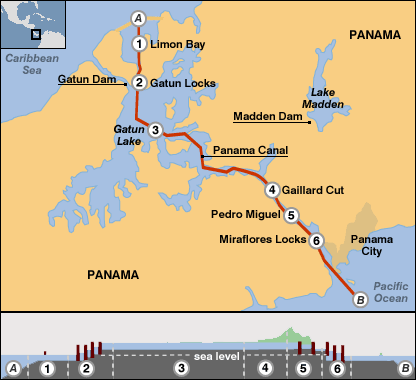Looking ahead - The Panama Canal
| PLANNING - Ocean to Ocean - The Panama Canal | |
 The Panama Canal is a major ship canal that traverses the Isthmus of Panama in Central America connecting the Atlantic and Pacific Oceans. Construction of the canal was one of the largest and most difficult engineering projects ever undertaken. It has had an enormous impact on shipping between the two oceans, replacing the long and treacherous route via the Drake Passage and Cape Horn at the southernmost tip of South America. A ship sailing from New York to San Francisco via the canal travels 9,500 km (6,000 miles), well under half the 22,500 km (14,000 mi) route around Cape Horn. The Panama Canal is a major ship canal that traverses the Isthmus of Panama in Central America connecting the Atlantic and Pacific Oceans. Construction of the canal was one of the largest and most difficult engineering projects ever undertaken. It has had an enormous impact on shipping between the two oceans, replacing the long and treacherous route via the Drake Passage and Cape Horn at the southernmost tip of South America. A ship sailing from New York to San Francisco via the canal travels 9,500 km (6,000 miles), well under half the 22,500 km (14,000 mi) route around Cape Horn.
Layout
The canal consists of seventeen articficial lakes, several improved and artificial channels and three sets of locks. An additional artificial lake, Alajeula Lake, acts as a resovoir for the canal.
Canal Lock Size
Initially the locks at Gatun had been designed as 28.5 metres wide. In 1908 the United States Navy requested that the locks should be increased to have a width of at least 36 metres. This would allow for the passage of US naval ships. Eventually a compromise was made and the locks were to be constructed to a width of 33 metres. Each lock is 300 metres long with the walls ranging in thickness from 15 metres at the base to 3 metres at the top. The central wall between the parallel locks at Gatun has a thickness of 18 metres and stands in excess of 24 metres in height. The lock gates are made from steel and measures an average of 2 metres thick, 19.5 metres in length and stand 20 metres in height.
Capacity
The canal is presently handling more vessel traffic than had ever been envisioned by its builders. In 1934 it was estimated that the maximum capacity of the canal would be around 80 million tons per year. Canal traffic in 2006 consisted of 278.8 million tons of shipping. Despite the gains which have been made in efficiency, the canal is soon expected to approach its maximum capacity. An additional complication is that the proportion of large (close to Panamax-sized) ships transiting is increasing steadily; this may result in a further reduction in the number of transits, even if cargo tonnage rises.
World ARC Transits
The yachts of the World ARC fleet will transit the canal as 'handliners' meaning they will not use the powerful locomotives to steady themselves in the locks but crew handling lines on board each boat. Its possible to view the lockage of each of the transit groups on the Panama Canal webcams.
Day 1. Gatun Lock, about 2200 UTC (in darkness) -
Day 2. Milliflores Lock, about 1600 UTC -
Click here for the webcam page
|
. |
Previous |
Next